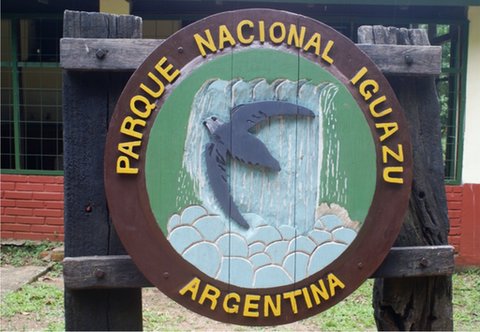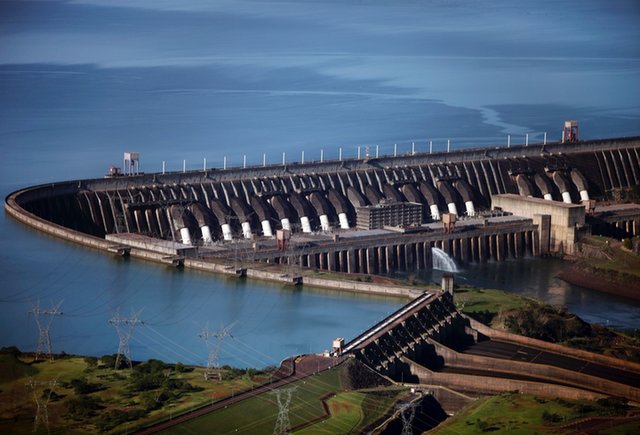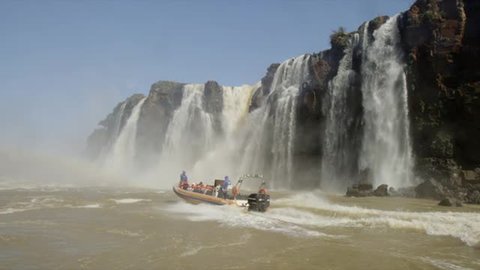PeopleandtheFalls
PeoplehavelivedintheareaaroundIguazúFallsformorethan10,000years.FirstweretheKaingang,followedbytheGuaraní.In1541,SpanishexplorerÁlvarNúñezCabezadeVacabecamethefirstEuropeantoseethefalls.Hecameacrossthemwhenhewassearchingforariverrouteto Paraguay.
Religiousmissionariesarrivedin1609,buttheSpanishforcedthemtoleavein1767.Itwasn’tuntiltheearly1880sthatWesterninterestintheareasurfaced again.
Followingascientificexpeditionofthearea,thefirsttouristtripwasorganizedin1901.Oneyearlater,planswereunderwaytocreatethefirstnationalparkinArgentina.IguazúNationalParkopened
in 1934.
InArgentina,peoplespeakSpanish,sothefallsarecalledtheIguazúFalls.InBrazil,theyspeakPortugueseandcallthemtheIguaçuFalls.

Thissignsays,"IguazúNationalPark,Argentina"in Spanish.
Fiveyearslater,itssisterpark,IguaçuNationalPark,openedacrosstheriverinBrazil.BothparkshavesincebeenidentifiedasUNESCOWorldHeritagesites.IguazúFallswasalsoselectedasoneofthe“NewSevenWondersof Nature.”
TroubleinParadise
AsmuchaspeoplewanttoprotecttheIguazúarea,peoplearealsoitsbiggestproblem.Poacherscomeintotheparkillegallytotaketreesandanimals.Peopleaccidentallyinjureorkillanimalswhiledrivingthroughthe parks.
Outsidetheparks,loggingandclearinglandforfarmsaretwoofthebiggestproblems.Whentreesdisappear,plantsandanimalslosetheirhomes.Somespeciesgoextinct.WatersourceslikeIguazúFallsareaffected, too.
Whenforestsaredestroyed,therearefewertreestoabsorbcarbondioxide.Whenthereismorecarbondioxideintheair,temperaturesrise.Risingtemperaturescanleadtolessrain.Andwhenthere’slessrain,thereislesswatertoflowover
the falls.

TheItaipuDamontheupperParanáRiverisoneofthelargesthydroelectricprojectsinthe world.
TouriststakeaboattourofIguazú Falls.
Peoplealsobuilthydroelectricdamsonthearea’srivers.Thedamshelpsupplyelectricitytothearea,buttheyalsoaffectthelevelofwaterintherivers.Plantsthatneedaconstanthumidenvironmentareharmedeachtimeadamisopened.Morethan1.5milliontouristsgoseethefallseachyear.Theregiondependsonthetouriststosurvive.Ifthefallsrundryorplantsandanimalsdisappear,peoplemaynolonger come.
WorkingTogether
OneofthebiggestchallengesinpreservingtheIguazúFallsregionisitslocation.Thefallsarenearthebordersofthreecountriesthateachhavetheirownideasonhowtomanagetheland.ArgentinaandBrazil,forexample,establishednationalparksinthe1930s.Paraguaynever did.
Thesecountrieshavehaddisagreements,particularlywhenitcomestodams.Yetinrecentyears,theyhavecometogethertocreatealong-termplanonhowtoconserveandmanagetheland.Importantpartsofthisplanincludemorepatrols,speciesmonitoring,education,
and research.
Recently,jaguarsbecameasignthattheplanisworking.Intheearly2000s,jaguarshadnearlydisappearedfromtheIguazúregion.Thecountriesincreasedpatrols.Researchersplantedcameratrapstodeterpoachers.Farmerswhousedtokilljaguarsthatpreyedontheirlivestockstartedplantingcornandsoybeans instead.

Jaguarsaremakinga comeback.
Asaresultoftheseactions,thenumberofjaguarshasdoubled.AndthispartofSouthAmericaistheonlyplaceintheworldwithagrowingjaguarpopulation.Ididn’tseeanyjaguarsonmytourofthepark,butthat’snottosaythatajaguardidn’tsee me!
People’seffortstomaketheparksbetterareworking.ThebeautifulfallsandotherIguazúsplendorsareworthseeing.Butmoreimportantly,theyareworth
fighting for.
Thisviewfromabove showspartofthespectacular falls.
